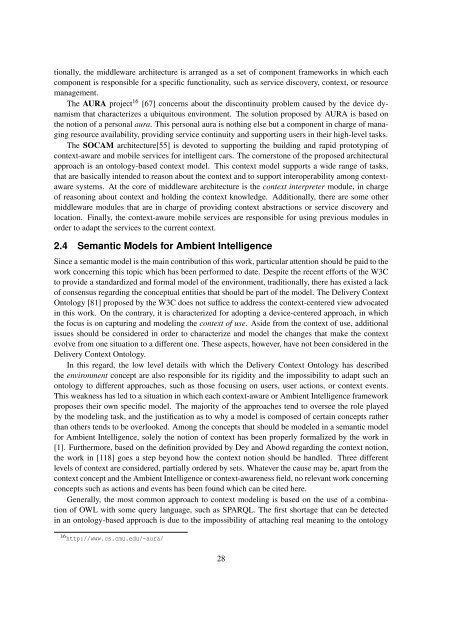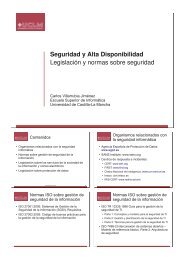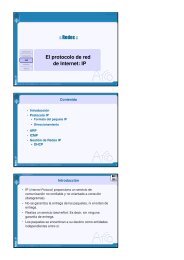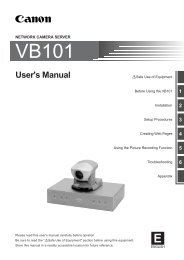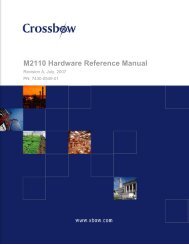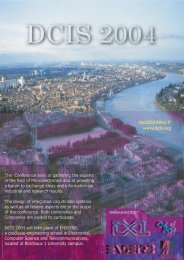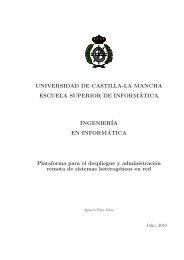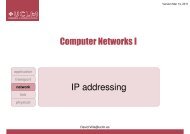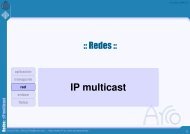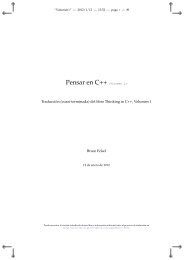tionally, the middleware architecture is arranged as a set of component frameworks in which eachcomponent is responsible for a specific functionality, such as service discovery, context, or resourcemanagement.The AURA project 16 [67] concerns about the discontinuity problem caused by the <strong>de</strong>vice dynamismthat characterizes a ubiquitous environment. The solution proposed by AURA is based onthe notion of a personal aura. This personal aura is nothing else but a component in charge of managingresource availability, providing service continuity and supporting users in their high-level tasks.The SOCAM architecture[55] is <strong>de</strong>voted to supporting the building and rapid prototyping ofcontext-aware and mobile services for intelligent cars. The cornerstone of the proposed architecturalapproach is an ontology-based context mo<strong>de</strong>l. This context mo<strong>de</strong>l supports a wi<strong>de</strong> range of tasks,that are basically inten<strong>de</strong>d to reason about the context and to support interoperability among contextawaresystems. At the core of middleware architecture is the context interpreter module, in chargeof reasoning about context and holding the context knowledge. Additionally, there are some othermiddleware modules that are in charge of providing context abstractions or service discovery andlocation. Finally, the context-aware mobile services are responsible for using previous modules inor<strong>de</strong>r to adapt the services to the current context.2.4 Semantic Mo<strong>de</strong>ls for Ambient IntelligenceSince a semantic mo<strong>de</strong>l is the main contribution of this work, particular attention should be paid to thework concerning this topic which has been performed to date. Despite the recent efforts of the W3Cto provi<strong>de</strong> a standardized and formal mo<strong>de</strong>l of the environment, traditionally, there has existed a lackof consensus regarding the conceptual entities that should be part of the mo<strong>de</strong>l. The Delivery ContextOntology [81] proposed by the W3C does not suffice to address the context-centered view advocatedin this work. On the contrary, it is characterized for adopting a <strong>de</strong>vice-centered approach, in whichthe focus is on capturing and mo<strong>de</strong>ling the context of use. Asi<strong>de</strong> from the context of use, additionalissues should be consi<strong>de</strong>red in or<strong>de</strong>r to characterize and mo<strong>de</strong>l the changes that make the contextevolve from one situation to a different one. These aspects, however, have not been consi<strong>de</strong>red in theDelivery Context Ontology.In this regard, the low level <strong>de</strong>tails with which the Delivery Context Ontology has <strong>de</strong>scribedthe environment concept are also responsible for its rigidity and the impossibility to adapt such anontology to different approaches, such as those focusing on users, user actions, or context events.This weakness has led to a situation in which each context-aware or Ambient Intelligence frameworkproposes their own specific mo<strong>de</strong>l. The majority of the approaches tend to oversee the role playedby the mo<strong>de</strong>ling task, and the justification as to why a mo<strong>de</strong>l is composed of certain concepts ratherthan others tends to be overlooked. Among the concepts that should be mo<strong>de</strong>led in a semantic mo<strong>de</strong>lfor Ambient Intelligence, solely the notion of context has been properly formalized by the work in[1]. Furthermore, based on the <strong>de</strong>finition provi<strong>de</strong>d by Dey and Abowd regarding the context notion,the work in [118] goes a step beyond how the context notion should be handled. Three differentlevels of context are consi<strong>de</strong>red, partially or<strong>de</strong>red by sets. Whatever the cause may be, apart from thecontext concept and the Ambient Intelligence or context-awareness field, no relevant work concerningconcepts such as actions and events has been found which can be cited here.Generally, the most common approach to context mo<strong>de</strong>ling is based on the use of a combinationof OWL with some query language, such as SPARQL. The first shortage that can be <strong>de</strong>tectedin an ontology-based approach is due to the impossibility of attaching real meaning to the ontology16 http://www.cs.cmu.edu/~aura/28
concepts. Concept meanings cannot be consi<strong>de</strong>red in isolation, and there is a great amount of knowledgeinvolved in enhancing concepts with meaning. However, at some stage, it can be argued thatthe complexity involved in enhancing concepts with such a complex and large amount of knowledgecan make the task of context mo<strong>de</strong>ling unfeasible. It is therefore necessary to find an equilibriumbetween the amount of knowledge required to provi<strong>de</strong> a close semantic <strong>de</strong>scription of a concept, andthe structure that allows such knowledge to be organized in a feasible way that can be used when reasoningand inferring about knowledge. Nevertheless, it should be remembered that ontology-basedapproaches have quickly achieved a high level of acceptance. The reason for this is mainly the factthat the knowledge mo<strong>de</strong>led using an ontological approach can afterward be easily shared and reused.The first of the semantic mo<strong>de</strong>ls surveyed here also implements the same ontology-based approach.The AMIGO project [114] proposes an architecture specifically <strong>de</strong>voted to managing context information,built upon a semantic mo<strong>de</strong>l of the context information, which at the same time is supportingthe information share among the different <strong>de</strong>vices that populate the environment. The AMIGO semanticmo<strong>de</strong>l un<strong>de</strong>rstands context as being a physical context with different functional domains (i.e.PC, mobile, CE, and home automation). This project therefore proposes a complex structure of differentontologies, grouped in a modular manner [121]. The notion of action or event is ignored as itis the relationship of such concepts with the context <strong>de</strong>vices.Additionally, the OWL-S, RDF, and SPARQL have been the technologies used for the implementationof the semantic mo<strong>de</strong>l and for querying it. As was mentioned above both technologies havescaling problems associated to them, since whenever the ontology is getting more complex, queriesare taking exponentially increasing time in being evaluated. Moreover, SPARQL is basically a languagefor querying an ontology that does not support real inference mechanisms. In this sense, thereis not much difference between querying a database and an ontology. Nevertheless, <strong>de</strong>spite the drawbacksassociated with the technologies employed, there are some strengths directly <strong>de</strong>pen<strong>de</strong>nt on thesemantic mo<strong>de</strong>ling of services proposed by the AMIGO project.Regarding the service semantic mo<strong>de</strong>ling, the ontology-based service discovery and the dynamicservice composition are two of the most challenging goals addressed by the AMIGO project.The main contribution of the AMIGO semantic mo<strong>de</strong>l is the tool they have <strong>de</strong>veloped to visuallyedit the context information ontology. The VantagePoint utility [70] facilitates the task of <strong>de</strong>alingwith the ontology context information for those that have not been trained in knowledge engineering.However, the semantic enhancement of services in AMIGO is basically inten<strong>de</strong>d to support semanticdiscovery and integration of Web services. However, the main drawback of this approach isgroun<strong>de</strong>d in the fact that the use of semantics has to be associated to Web services. There exists a <strong>de</strong>pen<strong>de</strong>ncyon the technology approach that needs to be implemented if services are to be semantically<strong>de</strong>scribed.Asi<strong>de</strong> from the technological aspects and focusing on the proposed mo<strong>de</strong>l itself, the main shortageof the AMIGO semantic mo<strong>de</strong>l is due to the service-centered approach it adopts. Despite beinglabeled as semantic, the accomplished service <strong>de</strong>scriptions are not groun<strong>de</strong>d in a knowledge base thatassociates meaning to the concepts, but rather, this approach is claimed to be semantic just on thebasis of the use of a common vocabulary. The role played by the proposed ontology is to standardizethe concepts involved in service <strong>de</strong>scriptions, however, such ontology should be supported, at adifferent level, on the meaning and knowledge that each concept and relationship of the ontology hasassociated.However, ontology-based approaches are not the only strategies to context mo<strong>de</strong>ling, and thework in [139] and more recently the work in [11] present a survey of some the approaches employedfor mo<strong>de</strong>ling purposes.29
- Page 1: DEPARTAMENTO DE TECNOLOGÍAS Y SIST
- Page 4 and 5: María José Santofimia RomeroTelé
- Page 7: ResumenLa Inteligencia Ambiental, p
- Page 11 and 12: ContentsContentsList of TablesList
- Page 13: CONTENTSVII7.4.4 The Plan Executor
- Page 17: List of Figures4.1 Kripke model for
- Page 21: Part IPreliminaries3
- Page 24 and 25: This gap poses an urgent need to de
- Page 26 and 27: and events, and the mechanisms to r
- Page 28 and 29: Maria’s ankle as an impediment to
- Page 30 and 31: 1.3 Aims and objectivesGiven that t
- Page 32 and 33: The fourth item concerns the way th
- Page 34 and 35: of such goals and desires and how t
- Page 36 and 37: tion, is addressed by coping with a
- Page 38 and 39: networking from being widely spread
- Page 40 and 41: The MERL’s Ambient Intelligence f
- Page 42 and 43: tions come into play. These scenari
- Page 44 and 45: interact with electronic devices, e
- Page 48 and 49: The idea behind the work proposed h
- Page 50 and 51: esources under a middleware based o
- Page 53: Part IIUnderstanding35
- Page 56 and 57: obvious. In this sense, sociologist
- Page 58 and 59: true throughout a time interval, or
- Page 60 and 61: application domain is (true, false)
- Page 62 and 63: (SubAsbstrac Nathan Nathan2007)(Sub
- Page 64 and 65: Moreover, events not only cannot be
- Page 66 and 67: epresented by means of the notion o
- Page 68 and 69: Context-awareness is one of the mai
- Page 70 and 71: In any case, the adopted behavioral
- Page 72 and 73: when the water level starts increas
- Page 74 and 75: Traditionally, these responses have
- Page 76 and 77: true.Additionally, the meaning of t
- Page 78 and 79: (6) Statement → Service-ID perfor
- Page 80 and 81: the set of possible contexts, and M
- Page 82 and 83: in which S is a nonempty set of sta
- Page 84 and 85: are considered possible given the p
- Page 86 and 87: cope with the demands involved in d
- Page 89 and 90: Chapter 5Understanding Context Situ
- Page 91 and 92: Figure 5.1: Overall view of the pro
- Page 93 and 94: adjusting existing knowledge to sim
- Page 95 and 96: of some events involves the stateme
- Page 97 and 98:
( new-statement { picker } {is loca
- Page 99 and 100:
The way of determining which after
- Page 101 and 102:
CL-USER > ( the-x-of-y-is-z { enter
- Page 103 and 104:
CL-USER > ( the-only-x-of-y-is-z {
- Page 105 and 106:
CL-USER > ( get-element-fluent ( lo
- Page 107 and 108:
The specificity of the propositiona
- Page 109 and 110:
Following the same dynamic, the dif
- Page 111:
part is intended to propose a solut
- Page 115 and 116:
Chapter 6Behavioral Response Genera
- Page 117 and 118:
and action selection by means of a
- Page 119 and 120:
wants the room to be at a higher te
- Page 121 and 122:
state of the world with those plann
- Page 123 and 124:
conflict. The later strategy requir
- Page 125 and 126:
Function f returns the actions, fro
- Page 127:
next step selected in the plan. The
- Page 130 and 131:
of it. It is also possible to try t
- Page 132 and 133:
Agent System (MAS), individual agen
- Page 134 and 135:
the requirements stated for the BRG
- Page 136 and 137:
The action planning algorithmMaking
- Page 138 and 139:
The advantages underlying service c
- Page 140 and 141:
effects. On the contrary, an approp
- Page 143:
Part IVValidation and discussions12
- Page 146 and 147:
taking place. The interpretation of
- Page 148 and 149:
The key elements of the evaluation
- Page 150 and 151:
also been proved to serve as a mean
- Page 152 and 153:
Table 8.2: Simulation Configuration
- Page 154 and 155:
the knowledge-base, it saves time i
- Page 156 and 157:
effects and the sensed ones leads t
- Page 158 and 159:
Table 8.3: Personal information of
- Page 160 and 161:
Scenario Interpretations Number of
- Page 162 and 163:
understand the terms used to descri
- Page 164 and 165:
Finally, the causal explanation app
- Page 166 and 167:
2. A2: To provide a service composi
- Page 168 and 169:
System has to be motivated by goals
- Page 170 and 171:
een addressed by this thesis. Howev
- Page 173 and 174:
Bibliography[1] Gregory D. Abowd, A
- Page 175 and 176:
[25] Diane J. Cook, Juan C. Augusto
- Page 177 and 178:
[54] Tao Gu, Hung Keng Pung, and Da
- Page 179 and 180:
[83] Clemens Lombriser, Nagendra B.
- Page 181 and 182:
[110] Davy Preuveneers, Jan Van den
- Page 183 and 184:
[134] John F. Sowa. Conceptual Stru
- Page 185:
Part VIAppendix167
- Page 188 and 189:
Ambient Intelligence environment, i
- Page 190 and 191:
invocation. However, in reality the
- Page 192 and 193:
consists in querying the Topic Mana
- Page 194 and 195:
Figure A.4: Multi-Agent System over
- Page 196 and 197:
The result of the planning algorith
- Page 198 and 199:
concepts and relationships are impl
- Page 200 and 201:
As listed below, the recognition ac
- Page 202 and 203:
184Figure A.8: Sequence diagram for
- Page 204 and 205:
}query = " ( b−wire ( car ( list
- Page 207:
Este documento fue editado con GNU


